A common problem for summer residents: leaves on tomatoes turn yellow - what to do and how to prevent this?
Tomatoes are a fastidious crop that requires regular and proper care. Mistakes and negligence of a gardener can result in crop failure or even death of plants. Therefore, you should be aware of possible difficulties and be prepared for them.
Among the most common problems are wilting and yellowing of the greenery on the bush. A symptom may indicate a plant disease, a lack of important microelements, or improper care. Let's look in more detail at the reasons why tomatoes' leaves turn yellow and dry out and how to deal with this phenomenon.
Causes of yellow leaves
Yellowing foliage on tomato bushes always indicates that the plant is feeling uncomfortable. If the right measures are not taken in time, it will die. Why did the bush change its appearance? Often the reason lies in mistakes made by the gardener. In some cases, this symptom can be caused by viral and fungal diseases.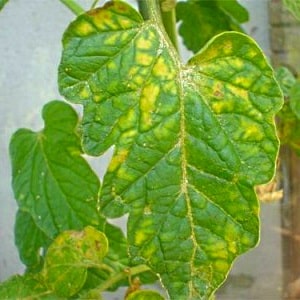
Lighting problems
Tomato is a light-loving crop. Lack of sunlight often occurs when growing tomatoes on the balcony and windowsill. Sometimes plants turn yellow if there is not enough light in the greenhouse. The light level needs to be increased. For this purpose fluorescent lamps are used.
Improper watering
The culture is demanding on humidity levels. In the first two weeks of growing seedlings, plants require almost extreme humidity, then such conditions become destructive for them.
Bushes change color with insufficient watering. Therefore, if the plants are yellow and the soil is dry, increase the frequency of watering. Similar symptoms occur when tomatoes are flooded: the water does not have time to evaporate, and the roots of the plants rot.
Recommendations:
- Water the tomatoes it is necessary abundantly, but not often; in hot summers, 2-3 waterings per week are enough.
- Water only at the roots. Moisture falling on the leaves leads to their rotting and wilting.
- Cold water is harmful to plants.
Incorrect landing dates
The seedlings are planted in a permanent place 55-65 days after sowing the seeds. Tomatoes planted in the ground later than the 65th day after sowing take root less well and often die.
Important! In overgrown seedlings, the roots do not form correctly. Due to the fact that it develops in a container with a limited size, the underground part of the tomatoes becomes weak.
Planting tomatoes in the ground early is also unacceptable. Plants will die due to overnight frosts.
Diseases and pests
The described problem can also arise due to diseases of a fungal or viral nature.
Diseases that cause yellowing of bushes:
- The curl is yellow. Viral disease. The upper part of the plant turns yellow, pronounced veins appear. The flowers on the tomatoes begin to fall off. It cannot be treated; the affected bushes are removed. The virus is transmitted by whiteflies, the appearance of which is prevented by spraying tomatoes with mineral oils.
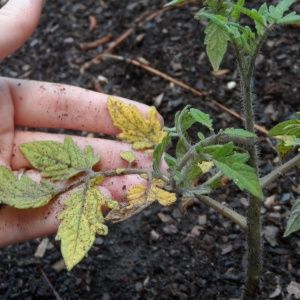
- Fusarium. Fungal disease: greens turn yellow, curl, lose turgor and dry out. Symptoms are especially pronounced at the growing point. A white coating appears on the underside of the leaves. Fungal spores land on tomatoes from contaminated plant debris and garden tools.If the bushes change slightly, they are treated with Falcon. If the disease has affected most of the bush, it will have to be burned.
- Blackleg. A common disease that affects seedlings. The plant stem darkens. There are no remedies that can help save diseased plants. If you notice the disease early on, carefully dig up healthy shoots from the contaminated soil and replant them in new, disinfected soil.
The color of the bush changes when infested with whiteflies, aphids, slugs and spider mites. Actofit will help get rid of pests.
Problems with the root system
When transplanting tomatoes, the gardener must act as carefully as possible: small roots are sure to be torn. If the damage is severe, the tomato will not recover. This will lead to rotting and death of its roots.
The older the plant, the less resistant it is to root damage during transplantation. It is important to comply with the picking deadlines. The underground part of the plant is often damaged during weeding and loosening.
The roots are attacked by various pests. For example, mole crickets and beetle larvae. A damaged root system is unable to supply plants with sufficient nutrients.
Incorrect feeding
Tomatoes are picky about soil composition. This is why it is so important to follow a feeding schedule. Plants are watered with fertilizers 3-4 times per season. The frequency of fertilizing depends on the composition of the soil.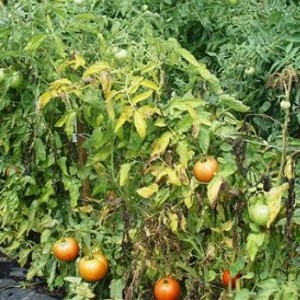
To enrich the soil even at the stage of preparing the beds, fertilizers are added to the soil. Gardeners advise using humus, manure, ash and chalk.
Foliar feeding with boron necessary for the proper formation of plant ovaries. They are used 2-3 times per season.
Nutrient deficiencies
Most often, tomatoes suffer from a lack of nutrients. This happens when feeding schedules are violated or the wrong fertilizers are used.
The lack of which elements causes yellowing of tomato foliage:
- Nitrogen. The greenery of the plants is paler and covered with reddish veins. To correct the situation, add urea to the soil.
- Potassium. Yellowing spreads throughout the leaf blade, causing it to curl. To compensate for potassium deficiency, potassium sulfate is added to the soil.
- Zinc and magnesium. With a deficiency of these substances, small yellow spots appear on the leaf blade. spots, the edges become reddish. The lesions quickly expand, causing leaves to curl inward and die. To compensate for the lack of zinc and magnesium, fertilizers containing these elements are applied.
- Boron, calcium and sulfur. Leaves with a deficiency of such elements are affected by necrosis. Plants shed ovaries and flowers. A complex fertilizer for tomatoes is required.
Excess nutrients
Excess nutrients are also harmful to tomatoes. In this case, the plants begin to “fatten”, which leads to a significant reduction in yield.
When there is an excess of what substances the leaves suffer:
- Nitrogen. Brown spots appear that grow throughout the plate. This causes the greenery to curl and die. The soil is watered with plenty of water and then allowed to dry.
- Chlorine. With an excess of chlorine, iron deficiency develops. To replenish it, tomatoes are sprayed with iron sulfate.
Hypothermia in the open ground
Tomatoes are heat-loving, so in our country not all varieties are suitable for growing in open ground. Most of them are not resistant to low temperatures.When overcooled, the root system of tomatoes begins to rot. In most cases, it is impossible to save such plants.
Other reasons
There are a number of other reasons why the above-ground part of tomatoes suffers. The list contains the most common of them:
- Increased soil acidity. Tomatoes love slightly acidic soil. To test the acidity of the soil, use litmus paper. To normalize acidity levels, add lime, chalk and ash.
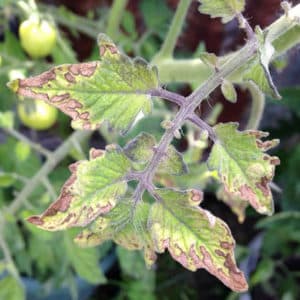
- Stress. Whenever transplanted, tomatoes experience severe stress. Therefore, often in the first two weeks after picking, their greens look wilted. If you do not follow the rules for preparing for transplantation, the stress can be so strong that the plants will die.
- Tight container. If a pot with a volume of less than 2 liters is used for balcony tomato varieties, then the plants will not have enough space. Because of this, a weak root system cannot cope with the supply of nutrients to the above-ground part of the plant.
- Increased humidity levels in a greenhouse and greenhouse. Humidity above 70% is detrimental to the crop.
Yellowing of leaves of seedlings
Tomato seedlings are grown indoors. Therefore, there are fewer reasons why leaves may turn yellow at this stage:
- Sowing seeds too often. If the distance between the seeds is less than 1 cm, the roots of the seedlings will intertwine, which will ultimately lead to their death.
- Small container for grown plants. When the first true leaves appear on the seedlings, they are planted in separate pots with a volume of at least 300 ml. In cramped containers, roots will not form correctly.
- Excess or lack of watering. Such mistakes are as destructive for seedlings as for adult bushes.
- Nitrogen deficiency. If all the rules for caring for seedlings are followed, but the bushes still lose their turgor, the reason lies in a lack of nitrogen.
- Hypothermia. Often, seedlings are grown on a windowsill, without thinking about the fact that drafts have a detrimental effect on tomatoes.
How to recognize the cause
What to do if the leaves of tomatoes turn yellow? Look at exactly how the color has changed, and pay attention to which leaves are damaged.
If the changes affected the upper part of the bush, then the most likely causes are disease and lack of nutrients.
The lower part of the bush suffers from hypothermia and damage to the root system. Old leaves often die off when tomatoes are transplanted into open ground.
How to prevent yellowing of leaves
Damage to the above-ground parts of tomatoes is easier to prevent than to treat.
Follow preventive measures:
- Disinfection. Seeds, soil and garden tools need to be disinfected. To do this, use a solution of potassium permanganate.
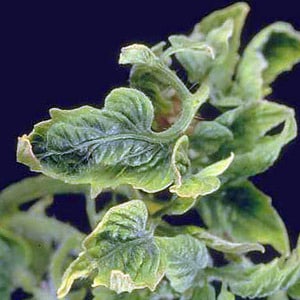
- Choose the right place for planting in open ground. Requires sunny areas.
- Treatment of plants with antifungal agents. For these purposes, Fitosporin and folk remedies are used.
- Ventilation of the greenhouse. The windows are opened daily.
- Proper watering. The soil is moistened 2-3 times a week with warm, settled water.
- Treatment of plants against pests. To do this, use a soap solution, a decoction of chamomile and celandine. Farmers use chemicals.
- Hypothermia warning. To prevent tomatoes from dying due to night frosts, they are covered with film in the first two weeks after planting.
- Compliance with the feeding schedule. Tomatoes are fed 3 or 4 times per season.
- Preliminary soil preparation. Remains of plants are removed from the soil.It is then disinfected and tested for acidity. If it is high, add ash or lime.
- Maintaining crop rotation. If you plant tomatoes in a place where nightshade crops have been grown for three years, the risk of their infection will increase significantly.
Recommendations and reviews from gardeners
Experienced gardeners know tricks that significantly reduce the risk of tomatoes dying.
Irina Vasilyeva, Krasnoyarsk: «I often came across black leg of seedlings. Neither disinfection nor seed dressing helped. A friend advised adding drainage to the containers for seedlings. I use shell rock. I haven’t encountered this problem since then.”
Evgeny Goncharov, Arkhangelsk: “To reduce the risk of yellowing of tomatoes when transplanting seedlings into a greenhouse, you need to take soil from the greenhouse. A few days before picking the plants, they are watered and fertilized.”
Read also:
Why do light spots appear on tomato leaves?
Early ripening and heat-loving eggplant “Vera” from domestic breeders.
A mid-season variety with fruits just like in the picture - the “Major” tomato.
Conclusion
If tomato leaves turn yellow, it means the plants need additional attention. There are many reasons: improper watering, untimely fertilizing, damage to roots during transplantation, disease. To find out for sure, you need to analyze your methods of caring for tomatoes.
It is impossible to cure already damaged leaves. However, by promptly eliminating the problem that caused such changes, you will save healthy parts of the plants.